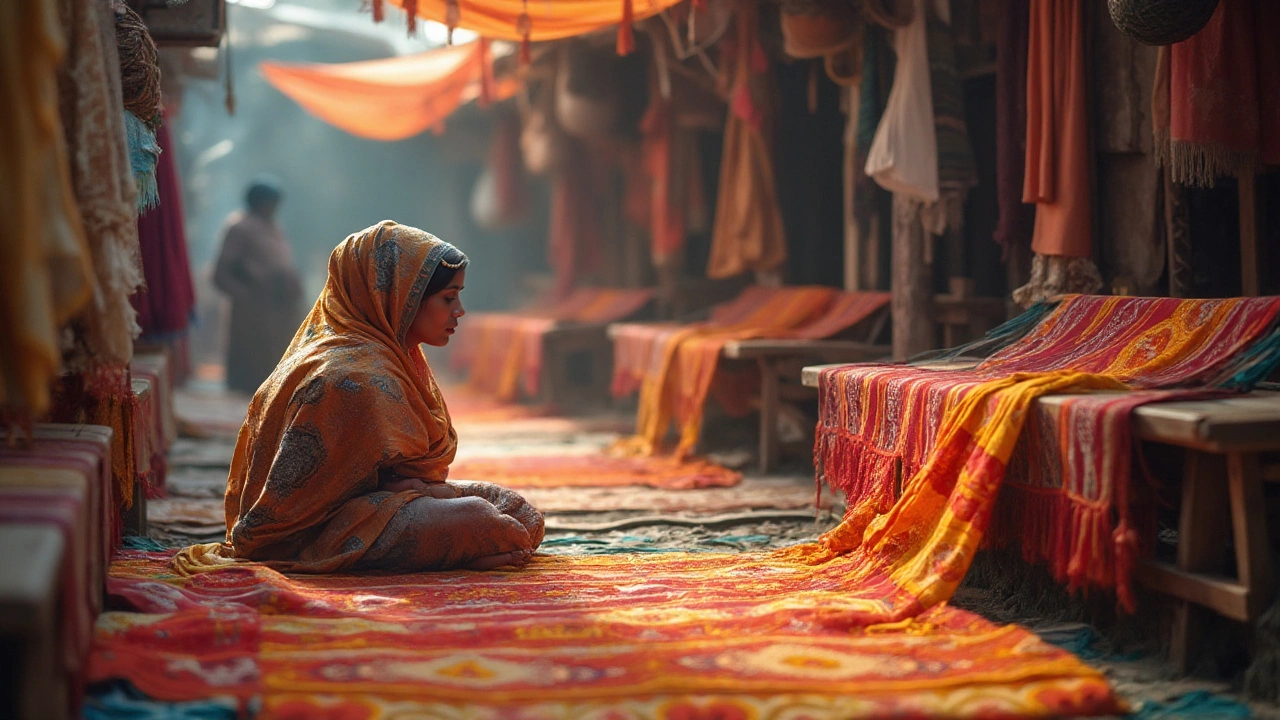
The Indian textile industry, a cornerstone of the nation's economy, finds itself at a pivotal moment as it ventures into 2024. This vibrant sector is not just a driver of employment but also a beacon of cultural heritage on the global stage. As the new year unfolds, manufacturers and stakeholders alike are keenly observing the winds of change, gravitating towards technological advancements and eco-friendly practices.
With India weaving an inclusive growth narrative, the focus is increasingly on sustainable production methods and innovation in fabric technology. A combination of government initiatives and a greater push for green textile products offer a promising horizon. This exploration aims to delve into the shifts poised to redefine the industry, offering insights into both the challenges and the potential for expansion.
- Emerging Trends in 2024
- Technological Advancements in Textile Manufacturing
- Sustainability: The Future Path for Indian Textiles
- Government Policies and Initiatives
- Market Dynamics and Consumer Behavior
Emerging Trends in 2024
The year 2024 promises to be a fascinating time for the Indian textile industry as it embraces several cutting-edge trends poised to revolutionize the sector. One of the major shifts is the increasing reliance on technology-driven processes. Automation and AI are expected to streamline manufacturing phases, reducing time and labor costs significantly. These advancements not only boost efficiency but also refine the quality of fabrics produced, offering a competitive edge in global markets.
Another key trend is the move towards sustainable and eco-friendly textiles. With climate change concerns mounting globally, more textile manufacturers are prioritizing sustainable practices. This includes utilizing organic cotton, recycled materials, and implementing eco-conscious dyeing techniques. As consumer demand for green products surges, Indian manufacturers are uniquely positioned to lead this charge, leveraging the rich tradition of handloom and natural dyes.
A focus on regional crafts and techniques is also making waves. As the world looks for authentic and ethical products, the value of traditional Indian textiles like Khadi and Chanderi is being rediscovered. This trend aligns with the government's 'Vocal for Local' campaign, intended to boost domestic manufacturing and support local artisans. It encompasses not only creating job opportunities across rural areas but also nurturing ancient crafts in the modern market context.
Personalized textiles are carving a niche too. With the advent of digital textile printing, customization has become more accessible and affordable. This technology enables unique designs on-demand, catering to individual tastes and preferences. The personalization trend rides on the back of e-commerce platforms, where made-to-order garments are gaining popularity among consumers who seek exclusivity in apparel.
Consumer Behavior and Ethical Fashion
Consumer behavior is shifting markedly towards ethical fashion, influenced by a growing awareness of the environmental and social impacts of fast fashion. This change is compelling brands to become more transparent about their supply chains. In 2024, expect to see more businesses adopting traceable production practices and fair trade certifications. As a reflection, the marketplace is swiftly evolving from price-driven choices to value-based consumption.
Finally, regional trade agreements are anticipated to open up new opportunities for the textile manufacturers in India. The proposed pacts with countries like Australia and those within the ASEAN region are expected to offer Indian textiles greater access to these markets, further enhancing export potential. According to a recent report, trade agreements could increase textile exports by an estimated 10% over the next year.
"The marriage of technology and tradition in the textile industry is not just about modernizing operations but also about adding layers of value to a timeless art," noted industry expert Raghav Mehta. This sentiment captures the essence of the ongoing transformation as manufacturers navigate a path that balances innovation with heritage.
The landscape of Indian textiles in 2024 is a vibrant tapestry woven with threads of innovation, sustainability, and cultural richness. As these trends unfold, they redefine not only how textiles are made but also how they are perceived by a discerning global audience.
Technological Advancements in Textile Manufacturing
In the evolving landscape of Indian textile manufacturing, innovation acts as the crucial thread weaving together the past with the future. The industry, deeply embedded in tradition, now stands on the cusp of a technological renaissance, welcoming state-of-the-art advancements that promise to revolutionize fabric production. From intelligent automation to the integration of AI-driven machinery, technology is revolutionizing efficiency, reducing waste, and enhancing product quality.
Automation is undeniably at the forefront of this transformative phase. Smart factories are becoming increasingly commonplace, where robotics and machine-to-machine (M2M) communication streamline processes that were once labor-intensive. This shift not only boosts productivity but also reduces human error significantly. Advanced software solutions are playing a critical role too, optimizing supply chains and ensuring that retailers can manage inventories with impressive precision.
The advent of IoT in textiles is another groundbreaking development. Embedded sensors within fabrics are creating intelligent textiles that can monitor health metrics or adjust to environmental changes. This intersection of technology and fabric production is unlocking possibilities once imagined only in science fiction. Moreover, 3D knitting machines are enabling custom fits and decreased lead times by fabricating entire garments from a single yarn, all while minimizing fabric waste.
According to a report by the Confederation of Indian Textile Industry, "The adoption of digital and robotics technology in textiles is expected to double productivity within the next five years."
Artificial Intelligence (AI) and Machine Learning (ML) are undeniably game changers in pattern recognition, predictive maintenance, and customization. AI algorithms analyze consumer data to forecast trends, allowing manufacturers to stay ahead of fashion demands. This tech-savvy approach also reduces trial and error, ensuring fabrics and garments meet consumer expectations the first time around. Enhanced quality control through AI surveillance can detect defects early in production, saving costs, and maintaining standards consistently.
Textile manufacturers are also capitalizing on blockchain for its transparency and security. This technology enables traceability from fiber sourcing to the finished product, a boon for sustainability-minded consumers. By ensuring accountability, blockchain technology is helping build trust between brands and consumers, a factor highly valued in today's conscious markets.
The trajectory towards technological integration in textile manufacturers India is inspiring, yet not devoid of challenges. The learning curve associated with these advancements calls for a significant upskilling of personnel. Workers accustomed to traditional methods must adapt to digital literacy, which presents both a hurdle and an opportunity for growth. Investment in training is paramount to fully harness these innovations.
The realm of 2024 trends in textile technology reflects a promising outlook for a sector that's driven by a thirst for innovation and excellence. India's journey to becoming a global leader in textile technology is systematically shaping up, catering to a digitally-driven market where efficiency and sustainability are not just choices but necessities.

Sustainability: The Future Path for Indian Textiles
The quest for sustainability in the Indian textile industry is gathering momentum as 2024 unfolds. Environmental considerations have pushed sustainability to the forefront, not just as a trend but as an essential shift in the production paradigm. Consumers today, significantly influenced by increasing environmental awareness, demand products that reflect their values, driving the push for sustainable practices. This movement is primarily fueled by urban millennial and Gen Z consumers who are willing to pay a premium for eco-friendly textiles. As a matter of fact, textile manufacturers in India are increasingly investing in green technologies that minimize waste and ensure energy-efficient processes. Strategic integration of renewable energy sources, such as solar power, in the textile production line is becoming more common, reducing the carbon footprint and drawing support from government policies that offer subsidies for sustainable practices.
Indian textile companies have started experimenting with organic and genetically modified fiber alternatives to lessen dependency on traditional cotton. The boon of bio-fabricated materials is offering a sustainable alternative with reduced water use and less harm to soil health. Emerging technologies like waterless dyeing and digital printing provide substantial conservation of resources by cutting down water consumption, a significant step for states facing water shortages. Apart from technological innovations, there is a renewed interest in reviving traditional craft-based practices known for their inherent zero-waste process, such as khadi weaving and handloom textile creation. This creates a dual benefit of sustaining cultural heritage while promoting sustainability. These sustainable strategies are not only helping to stabilize ecosystems but are also opening doors to new markets and collaborations internationally.
As sustainability becomes an integral part of the textile strategy, reliance on material traceability and ethical sourcing is essential. Traceability in the supply chain allows businesses to monitor the authenticity and sustainability credentials of their products. Several Indian companies are adopting blockchain technology to enhance transparency. Certification standards, like the Global Organic Textile Standard (GOTS) and OEKO-TEX, are adopted to reassure consumers and international partners of the industry’s commitment to ethical practices. A report from McKinsey reveals that sustainability investments can drive up to a 25% increase in long-term profits as consumer loyalty towards green brands solidifies. Many industry leaders believe this path will not only cater to the growing demand for sustainable products but also redefine the competitive landscape of the textile industry.
According to a recent United Nations report, "India's pivot to green textiles could significantly reduce the global environmental impact of fashion." Harnessing this potential, textile manufacturers in India can actively engage in forums and associations focused on sustainable development, such as the Sustainable Apparel Coalition, to better align with global objectives.
Collaboration, both domestic and international, is crucial for sustainability to make a significant impact. By partnering with international brands that champion sustainable textiles, Indian manufacturers can increase their market share while contributing to a global cause. In 2024, India's textile sector is poised to balance its rich tradition with modern sustainable innovations, setting a benchmark for textile producers worldwide. In doing so, India can not only address the local socioeconomic challenges but also lead pioneering steps towards a sustainable future.
Government Policies and Initiatives
The Indian government has been proactive in steering the Indian textile industry towards a path of sustainable growth. One of the significant moves is the amendment of the Technology Upgradation Fund Scheme (TUFS), aimed at boosting technology integration within the textile sector. By incentivizing modernization projects, this scheme supports the industry's transition to more efficient and technologically adept operations. A notable impact of TUFS is the increase in the adoption of green technologies, which aligns well with the global push for environmentally friendly practices.
Amidst these initiatives, the government has also rolled out the National Textile Policy, crafted to create a framework for not only innovation but also job creation and increased production capabilities. The policy emphasizes the enhancement of supply chain resilience and aims to triple exports by the end of this decade. Support for Small and Medium Enterprises (SMEs) through financial aid and access to resources plays a crucial part in this policy, ensuring that even the smaller players have ample opportunities to thrive.
Additionally, the focus on sustainability cannot be overstated. In line with global environmental goals, initiatives like the Sustainable Textiles Mission are being championed. This mission encourages manufacturers to adopt sustainable raw materials and focus on energy-efficient production processes. The buzzword 'sustainability' is no longer just a trend but a necessary transformation that the Indian textile industry is steadily adopting. A synergy between government policies and industry adaptation strategies is seen as a way forward to gaining a competitive edge in the global market.
Addressing domestic challenges, the government has also launched the Integrated Processing Development Scheme (IPDS), which targets the processing sector that often faces environmental compliance issues. The scheme funds infrastructure assistance to support the treatment of effluents and pollution control, thereby aiding in achieving stringent environmental compliance standards. This assistance is pivotal in enhancing the environmental footprint of the industry and aligning with international best practices.
To further bolster the sector, initiatives such as skill development programs have been introduced. These programs bridge the gap between education and employability, ensuring a skilled workforce to meet the evolving demands of the textile manufacturers. The focus is on equipping workers with the latest skills required for advanced textile production techniques, thus promising a future-ready workforce.
Moreover, a recent declaration by the Ministry of Textiles emphasised increasing collaborations between research institutions and the industry to fuel innovation. This collaborative approach is expected to drive advancements in areas like technical textiles, which offer substantial economic potential. As the industry enters this new phase, the combined efforts of policy frameworks and industry commitment underscore the vision for turning India into a global textiles hub, promising a bright future for both manufacturers and consumers alike.

Market Dynamics and Consumer Behavior
The Indian textile industry, brimming with potential, finds itself in a dynamic state, influenced by diverse consumer behavior and shifting market trends. At its core, the Indian market is a tapestry of culture, tradition, and modernity. Consumers today are increasingly aware, driven by a combination of digital proliferation and a global outlook. They are seeking transparency, authenticity, and innovative designs that offer both aesthetic appeal and ethical assurance. The industry's pivot towards more sustainable practices is a direct response to such consumer demands. Young shoppers are particularly interested in products that contribute to environmental conservation, a trend that's gaining momentum across urban centers.
Economic factors play a significant role as well. Rising disposable incomes and changing lifestyle preferences contribute to a growing appetite for diverse textile products. Brands are tailoring their offerings to suit a variety of tastes, from traditional ethnic wear to modern street fashion. One can observe that the desire for customized and bespoke textiles is becoming paramount, as individual expression fuels the consumer's journey. Additionally, online platforms have revolutionized the way buyers interact with textiles, driving e-commerce growth. "The way consumers shop has fundamentally changed; it’s an era of digital discovery," notes Raghav Singh, an industry analyst.
The contemporary consumer wants it all: comfort, style, and sustainability," Singh elaborates.
Digital Transformation and Consumer Insights
In the digital age, understanding consumer insights is crucial. Social media platforms, data analytics, and AI-powered tools enable manufacturers and sellers to predict trends and adapt swiftly. This digital transformation is particularly evident in the Indian textile sector, where brands can engage directly with their customers, obtaining real-time feedback. Virtual try-ons and augmented reality features are bridging the gap between physical and online shopping experiences, enriching the buying process. Stakeholders are increasingly investing in digital infrastructure to harness this potential, placing technology at the forefront of their growth strategies. Consequently, the sector's ability to cater to niche markets and individualize offerings boosts consumer satisfaction and loyalty, reshaping market dynamics.
Interestingly, a recent survey revealed that approximately 68% of consumers are more likely to purchase from brands that offer an ethical track record along with innovative features. Such statistics reflect a broader trend of conscious consumption. Indeed, the Indian textile industry stands on the brink of a consumer-led revolution, requiring agile responses and forward-thinking strategies. As the nation marches towards a more responsible future, the dynamics of market and buyer behavior will undoubtedly remain a pivotal engine for growth, ensuring the industry’s prominent position on the global stage.